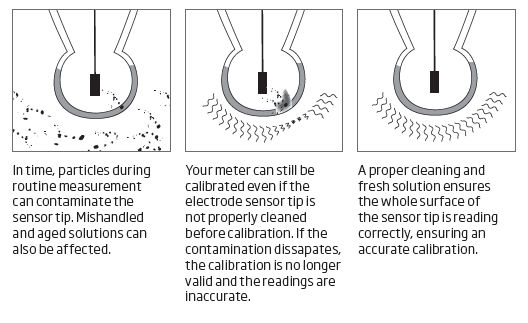Description
The most common cause for pH measurement inaccuracies is an unclean or improperly cleaned electrode. This is very important to note, because during calibration, the instrument assumes that the electrode is clean and that the standardization curve created during the calibration process will remain a valid reference until the next calibration. The pH meters on the market today will allow an offset voltage (pH 7.01) of approximately ±60 mV. The deviation from 0 mV is not unusual but ideally should be no greater than ±30 mV. The calibration process compensates for the change in offset voltage. If the mV offset continues to deviate and the meter is calibrated then any changes to the probe will result in inaccurate readings.
Cleaning is a fast and effective routine that should be performed on a regular basis as a preventative measure against using a dirty electrode and to ensure that the junction is not clogged. By simply immersing the electrode in the HI70614L cleaning solution for 15 to 20 minutes will dissolve any mineral deposits or other coatings.
After any cleaning procedure is performed it is important to rehydrate the glass of a pH electrode by placing in storage solution for 15 minutes. After the probe is rehydrated then a calibration must be performed. This is very important for process probes since many are used to monitor and control the dosing of chemicals. It is critical that the probe is clean and calibrated in order for a meter to maintain the ideal set point. The cleaning of pH and ORP process probes should be part of a routine maintenance program.
Air tight bottle with tamper-proof seal
- Ensures quality and freshness of solution
Each bottle marked with lot number and expiration date.
- Hanna cleaning solutions are specially formulated to have an expiration of 5 years from manufacture for an unopened bottle.
All prices are inclusive of GST and not all items are stock items, if you require an immediate solution please send an email to sales@hannainst.com.au or call us on (03) 9769 0666.
Free standard delivery: We offer free delivery within Australia on orders over $100, typically arriving within 5 to 7 days. Delivery times may vary depending on the courier service and the recipient's location. Free shipping is not available with other offers or discounts.
Same-day despatch: Place your order before 1 PM Monday to Friday for same-day despatch. Delivery times may vary depending on the courier service and the recipient's location. Subject to stock availability.
Please note that we do not offer shipping to PO Box addresses.








